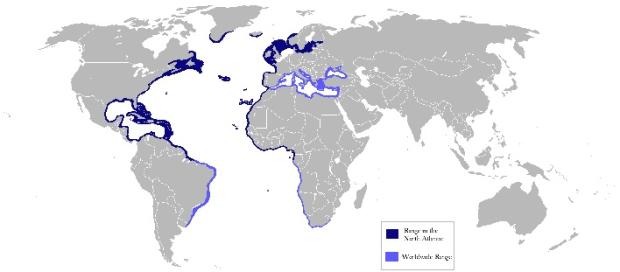Appearance
- The Atlantic bonito can grow up to 12 pounds and 30 inches long. They are mainly silver with blue-green dorsal fins and black stripes along the body.
- The Atlantic bonito has the same body shape as the tuna species. The only difference is that Atlantic bonito are skinnier than tuna. The Atlantic bonito has small, sharp teeth, as well as short pectoral fins. They have finlets behind the anal fin that stabilize the fish when swimming.
Atlantic bonito facts
- Species name: Sarda sarda
- The Atlantic bonito is a ram ventilator, meaning it cannot bite. They must eat their pray whole. That is why they eat mostly smaller fishes like mackerels, menhaden, and sand lance. Predators of the Atlantic bonito are larger fish like tuna, marlin and wahoo.
- Again, the Atlantic bonito is a largely unknown species. Their reproduction method is a mystery, but we know the Atlantic bonito mainly spawns in June.
- Atlantic bonito are a pelagic species, meaning they live in the middle of the sea in the open water. They are not found on the bottom of the ocean or near the top. Sometimes, they will come close to shore and enter estuaries.
- Atlantic bonito are not an important commercial species in the United States. You can, however, go recreational fishing for them.
- NOAA Fisheries manages Atlantic bonito. They follow the requirements of the International Commission for the Conservation of Atlantic Tunas.
- The Atlantic bonito lives throughout the western Atlantic Ocean, from Nova Scotia to Argentina. There is little activity in the Caribbean Sea and Gulf of Mexico.
Angling tips
Here are some tips for catching Atlantic bonito:
- Often, bonito will be jumping at the surface of the ocean chasing bait. They may be surrounded by birds trying to catch prey, so keep an eye out.
- Fast moving lures or bait is your best bet for luring in Atlantic bonito. We suggest menhaden, mackerel, or sand lance for bait. Troll at or near the surface, jib, or surface cast for this fish.
- Motor the boat near the school of fish, not through it. Motoring through can scatter the school, making it difficult to relocate the fish.
Atlantic bonito are an oily fish, which makes it good for bait and not much else. You can steak and grill the fish, or bake and chill it, as some countries do.
To learn more about the Atlantic Bonito, contact Dr. Gregory Skomal at (508) 990-2860 x 136 or gregory.skomal@mass.gov.

